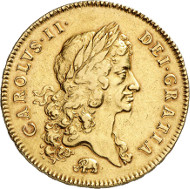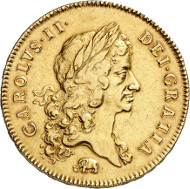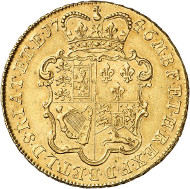Great Britain’s 5 Guineas
On March 27, 1663, the English King proclaimed the guinea official currency. That was only one measure of Charles II that affected the coinage. Shortly before, he had the entire mint converted from hammering to milling. Legend has it that the embarrassing difference between the coins made in France, which Charles II had seen during his exile, and the poor English pieces had prompted the king after his return home to appoint a French technician called Peter Blondeau and to purchase new machines worth 2,710 pounds. With these machines the English minting was revolutionized.
One of the new denominations was the 5 guinea piece, which – similar to the 1 guinea piece – was graced by the royal portrait on the obverse while the reverse exhibited the coat of arms of England, Scotland, France, and Ireland. A remarkable feature is the little elephant beneath the ruler’s bust. Just like the name of the coin, this element hints at the origin of the gold that was used for this coinage.
The first 5 guinea piece: Charles II, 1660-1685. 5 guineas 1668, London. Seaby 3329. From the upcoming Künker auction 258 on January 29, 2015. The piece has been estimated at 8,000 euros.
In 1618, the English King had granted a charter to a trading company for trade with West Africa. Favorite trading partners were the Ashanti in Guinea, today part of Ghana. The logo of the company responsible for the trade since 1663, bearing the name “Company of Royal Adventurers of England Trading to Africa”, was the elephant with the castle on his back. He, or the simplified variant without the castle, respectively, is depicted on the first 5 guinea piece of Charles II from 1668.
How these new coins were produced is reported by a visitor of the mint, the diarist Samuel Pepys. He writes that in a first step strips were cast whose thickness was then reduced by rolling machines. The machines were driven by horses who constantly worked in the basement below the coining room where they kept a kind of mill running.
After the balancier had punched out the planchets the edge inscription was added. It was the most important security feature in those days, and Blondeau bound all workers to utmost secrecy by oath. Only after the edge inscription had been added, the actual minting was done, likewise by the use of a balancier. Changing the planchet between two blows was rather dangerous but according to the legend, there were still some men who successfully managed to read the newspaper at the same time.
A 5 guinea piece made of Lima gold: George II, 1727-1760. 5 guineas 1746, London. Seaby 3665. From the upcoming Künker auction 258 on January 29, 2015. The piece has been estimated at 10,000 euros.
For more than 100 years, the 5 guinea pieces continued to be the largest denomination Great Britain had to offer. While the value had been 20 shillings at the start, it varied over time, rose and fell according to the gold price. The location the gold came from likewise changed. After the attack on Spanish Vigo, proud Queen Anne had her 5 guineas inscribed VIGO, just like George II who had LIMA added to his coinage from 1746. Admittedly, Lima had not been raided but Captain George Anson, on the occasion of his circumnagivating the globe in his function as royal pirate, had made a lot of booty which could be dispersed amongst the people. Plus, LIMA simply sounded much better then PIRATES’ BOOTY.
The last and most expensive 5 guinea piece: George III, 1760-1820. 5 guineas 1773, London. Pattern with plain edge. Seaby 3723. From the upcoming Künker auction 258 on January 29, 2015. The piece has been estimated at 100,000 euros.
Be that as it may, George II was the last British ruler who issued 5 guinea pieces on a large scale. From George III there is only one extremely rare pattern of the 5 guinea piece extant although theses coins were never given into circulation.
The minting reform of 1813 rendered this denomination obsolete anyway. The guinea was replaced by the sovereign. Only aristocrats still clinging to the good old days continued to calculate in guineas, when they went to see their tailors or bought a horse at an auction. Although the pound successfully made its way even to horse auctions in Great Britain, there are still horse races today that bear the title “1,000 Guineas”.
If you are interested in the coins featured in this article, you can go directly to the Künker Berlin-sale, where they are on offer.
Of course, CoinsWeekly is also offering an auction preview of this sale.














